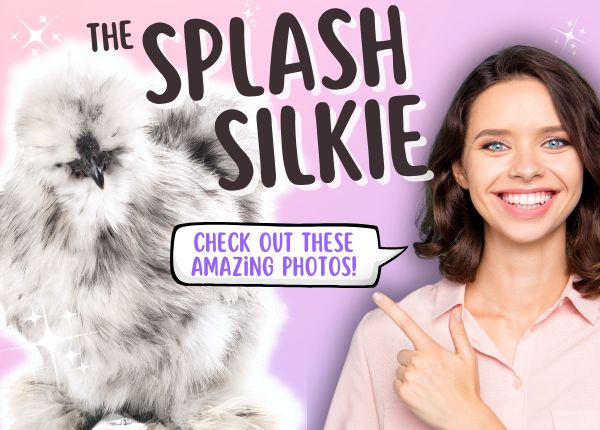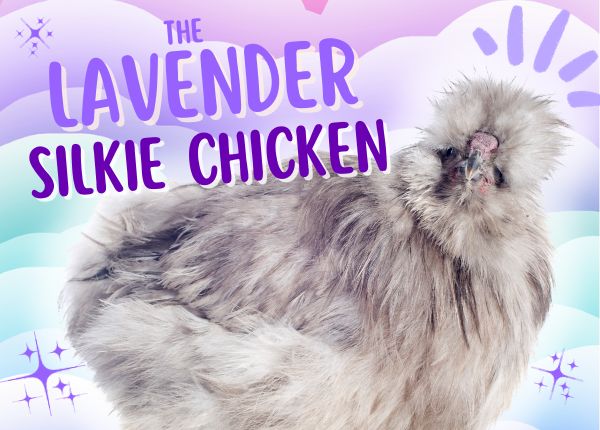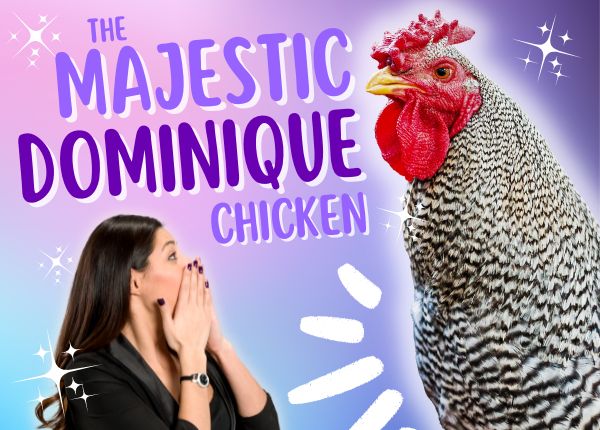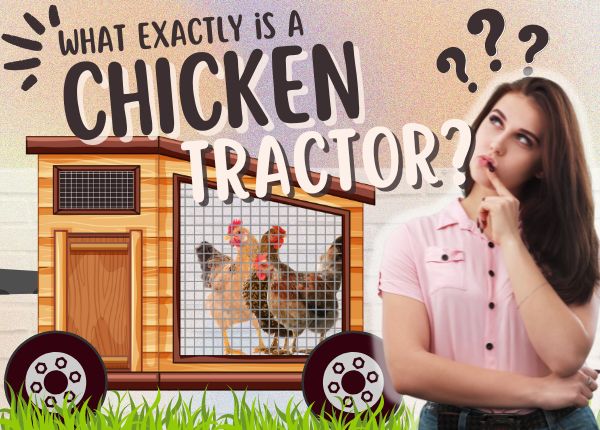
The splash silkie has well and truly made a splash on the chicken scene! As the newest variety of silkie to hit the American Poultry Association standards in 2000, splash silkies have been flaunting their Insta-worthy feathers with poultry pride. They’re stunning, and I think they know it.
I'm going to cover everything you need to know about Splash Silkie Chickens from caring for splash silkie chickens, to colour varieties, where to buy them and what to name them! Stick around till the end to download my free Silkie Hen Heath Check too!
Let’s cluck to it!
Splash silkies are like other varieties of silkie in every way other than the pattern of their plumage. Splash silkies have highlights! Well…technically, they’re lowlights.
Splash silkies have light blue, or greyish feathers with darker blue, slate grey, or black splashes of color. There are no prizes for guessing where the inspiration for their name came from. Those splashes of darker color are only on the tips of some feathers, which are also light blue at the base.
The best thing about splash silkies is that they are all so wonderfully unique in their patterning. Their color splashes are like feathery fingerprints, and if you're clucky enough to have more than one splash silkie, then you can guarantee that they’ll all look different.
For the same reason that splash silkies all look a little different, they are also challenging to breed. That couture coloring has some specific genetic demands. If you want to breed and hatch healthy splash silkies then you’ll need to be confident about your bloodlines and breeding knowledge. I’ve unscrambled the genetics behind breeding splash silkies and simplified the science bit in this article.
If you’re not planning on breeding your backyard birds, then don’t be put off these pretty chicks by their breeding complexities. They’re designer, but they’re not divas. So long as you source your splashes from a reputable breeder, then they will be just as happy, healthy, hardy, and manageable as any other silkie variety. Go for it! They’re too lovely not to.
Thinking of starting out with Silkies? You’re not the first. Silkies are a popular beginner’s breed for a reason.
Chickenpedia is the perfect next step before you head out to the hatchery to pick your chicks. Find out everything you need to know about buying healthy silkies, what to buy for them, what they need, and how to get loads of yummy eggs!🥚
You’re about to learn how to recognize, care for, and breed splash silkies, how to spot the difference between splash silkies and paint silkies, and I’ve even treated you to some name ideas for your new flock members.
“Splash Silkies are very docile, easy to care for, and handle confinement extremely well…Silkies are the most popular bantam breed we sell.” (The Chick Hatchery)
The Splash Silkie

Splash silkies have creamy-white or very pale blue feathers, some of which are tipped with those special streaks of darker blue or black. The tipped feathers tend to grow in messy groups, creating splashes of color.
In true silkie style, everything else about splash silkies is black, including their skin, beaks, legs, toes, and even their bones. They also have those statement turquoise earlobes which pop against their punky plumage.
Like all silkies, splash silkies have fluffy, feathered legs and five toes on each foot. They should always have beards, muffs, and fluffy little crests on their heads. They should also be sporting those statement splashes of dark blue or black.
Most color varieties of silkie are recognized in bearded or non-bearded varieties. You can probably work out what the difference is. However, self-blue (lavender) and splash silkies are the only varieties that must be bearded to be recognized within the APA standards. You can find splash silkies which are non-bearded, but these are more common in the UK and Europe.
Silkies are true bantams, meaning they’ve always been petite poultry. Splash silkie hens weigh 3 lbs and are 8–10 inches tall. Splash silkie roosters are a little larger weighing 4lbs and standing at 8–11 inches tall.
You might hear about ‘standard-sized’ or ‘large fowl’ silkies, which is confusing since these are still small chickens. Large fowl silkies have been bred up in size from the original bantams rather than the usual process of bantams being developed as mini-mes of their larger predecessors. Standard-sized silkies are mainly found in Europe and still make wonderful, family-friendly chickens just like the bantams.
“One of the most popular and unique breeds of poultry is the Silkie chicken” (APA)
Splash Silkie or Paint Silkie?
Splash silkies and paint silkies both look like they’ve been splashed with paint, so it’s no wonder that they’re so often confused with one another.
Splash silkies and paint silkies aren’t the same: they have different genetic makeup, and they look different too, if you know what you’re looking for.
Splash silkies have entirely blue feathers, though they are very pale blue, and have splashes of darker blue or black on the tips of some of their feathers. Paint silkies have white feathers and more defined patches of entirely black feathers.
I think of splash silkies as the ones with streaks or low lights, and paint silkies as the spotty or dotty ones: the dalmatian-design silkies.

The splash silkies’ base color of pale blue looks greyer to the untrained eye, which makes complete sense since these ‘blue’ feathers are actually black feathers ‘gone wrong’. Don’t be put off by that thought though: the silkie’s statement fluffy feathers are – after all - faulty feathers. The silkie has always rocked its flaws!
Splash Silkie Eggs
Splash silkie hens lay 2-3 small, cream-colored eggs a week. That’s around 100 eggs a year. Sometimes splashes coordinate with their clutches and lay speckled eggs, but this isn’t due to their variety, it’s just a silkie thing.
Silkies are considered a bit below average when it comes to egg production, but on the flip side of that egg, they’re cold-hardy and lay consistently throughout the colder months.
Caring For Splash Silkies:
Splash silkies are a great backyard breed and they’re brilliant for beginners. They don’t need much space since they’re so diddy, they’re friendly and easy to care for, they’re not too noisy, they’re not flighty or skittish, and they’re undeniably gorgeous girls.
One of the best things about silkies is how well-suited they are to homes with noise-averse neighbors. Silkies are also quiet chickens. Momma hen is even considerate when she's laying her eggs and her egg song is subtle and sweet in comparison to other breeds (not to mention some of the ladies I’ve met on the maternity ward. Yes, you, bed 12).
There are tricks to the trade of keeping healthy silkies. One thing to watch out for is that the silkie chicken breed does not handle damp conditions. Period! It’s not because they’re precious about their pom-pom looks, it’s those pesky unbarbed pennaceous feathers that refuse to offer any resilience to water.
Dd you know that some foods can poison silkies? No. Then Chickenpedia’s dietary courses could be lifesaving for your silkies.
Blue-Black-Splash Silkies
Splash coloring is found in lots of different chicken breeds, and it’s always caused by the same blue gene.
If you aren’t interested in breeding your hens, then you don’t need to worry about the science that goes on behind the breeding scenes. It makes no difference to how you should care for your coop buddies.
You might spot the abbreviation BBS which stands for Blue-Black-Splash and refers to the color genes that make up the splash silkie’s quirky color.
There are two different blue genes involved in chicken breeding. The self-blue (or lav) gene involved in breeding lavender silkies can have health implications as it impacts the structure of their feathers, but the Andalucian blue gene involved in the genetic makeup of blue-black-splash silkies doesn’t impact their feather quality or health in any way.
You’ve probably realized that blue chickens aren’t all that blue, but more of a slatey-grey color. This blue gene in chickens is called a diluting gene which can dull down the impact of the black gene, so it makes perfect sense that chickens with the blue gene can look greyish. Sometimes…
One chicken genetics class you can’t skip is that (Andalucian) blue doesn’t breed true. Black is a dominant color gene, so if you breed a black hen and a black rooster, then they’ll have black chicks. That’s called breeding true.
Andalucian blue is a diluting gene, so if you breed a blue hen and a blue rooster you won’t always get blue chicks. That’s known as not breeding true, and it’s what makes breeding splash silkies tricky.
“The Andalusian blue gene, when homozygous, creates "Splash" or "Blue Splash" feathers. These birds are muddy or bluish white with occasional, randomly "splashed", black feathers. Splashed plumage can be very attractive, especially in Silkies.” (Alan Stanford, Ph.D.)
Lavender Splash Silkies
Lavender Splash Silkies are both marvelous, and marvelously confusing! They’re a mix of Blue-Black-Splash silkie (the Andalucian blue gene) and lavender silkie (the self-blue gene).
“A Silkie that is lav/lav (Homozygous Self Blue) and Bl/Bl (Splash) can be called Self Blue Splash…Self Blue Splash males have an odd splotchy color that is neither Self Blue nor Splash. You’ll have a nice shade of light blue as the background color and a few dark blue feathers at irregular intervals on the coat. Self-Blue Splash females are a little prettier. They are less irregular looking than the Andalusian Splash females and almost look speckled.”(Inga Ladd & Alan Stanford, Ph.D.)
Golden Splash Silkies

Splash Silkies tend to be variants of blue and black, but you can also get the most stunning golden splash silkies. They have white plumage with splashes of golden blonde. So pretty! 😍
Breeding Splash Silkies
Splash Silkies aren’t difficult to breed from a behavioral point of view, but selecting the right genetic hatch match for your hen can prove to be complicated if the color of your chicks matters to you.
Silkie hens are amazing mommas. They’re broody by nature which makes hatching chicks at home easier than with other less motherly breeds.
I don’t want to dull down the joys of this little lady with a genetics class, but cluckily, the science bit is quite fascinating! To hatch a healthy splash, there’s some math you need to know:
Two blue chickens will hatch blue chicks, just not always. A clutch of chicks will be roughly 50% blue, 25% black, and 25% mixed. Those mixed ones are the splash chickens.
Splash silkies do breed true, so if you have two splash silkies you will get 100% splash chicks. So, what’s all the fuss about then? That’s easy enough?
If your splash silkies both carry a recessive white gene, then you may have some white chicks. The only way to know that they don’t carry this gene is to be confident in their entire bloodline. There’s also the worry that breeding splash with splash results in lighter and lighter-colored feathers. To keep the depth of color, you’ll need to breed back to black on occasion. Best in the hands of the experts, I think!
The Math of Splash Silkies

- Breeding Black & Black = 100% Black chicks
- Breeding Blue x blue = 25% black 50% blue 25% splash.
- Breeding Splash & Splash = 100% Splash chicks
- Breeding Black x blue = 50% blue 50% black.
- Breeding Black x splash = 100% blue.
- Breeding Blue x blue = 25% black 50% blue 25% splash.
- Breeding Blue x splash = 25% blue 75% splash.
Splash Silkie Chicks
Splash silkie chicks are mainly white with little splashes of black or blue. Whilst every splash is different, chicks do tend to have more splashes of color around their wings and tails. Chicks have black skin, beaks, legs, and toes. Silkie chicks are bundles of fluff all over, but you might be able to pick out little beards, muffs, and little crests.
Splash Silkie Chicken Names
The splish-splash style of your splash silkie is bound to give you some brilliant name ideas. It’s a bit like spotting shapes in the clouds. But, if you need a little inspiration, here are 22 splashtastic name ideas for your designer chickens! 😍

SHOW US YOUR SPLISH-SPLOSH SPLASHES!
Perfect poultry Pics in the comments, please.
Splash Silkies are ditzy designer chickens with down-to-earth attitudes. Sure, they might be a little trickier than other silkie varieties to breed, but they’re no harder to care for and there’s no reason why even beginner chicken keepers can’t start out with these fancy chickens.
If – like me - you’re smitten with silkies and can’t get enough of these cute and crazy fluffy butts, then surely the splash should be the next addition to your coop?
Whatever breeds of chickens you keep, a solid understanding of their needs and their temperament is an absolute must before adding any egg-stra hens to the henhouse.
Chickenpedia’s chicken breed course is the best way to get to grips with which breeds you should and shouldn’t mix, and which breeds are suitable for you and your lifestyle. Their breed course covers everything from a breed's personality, laying ability, health issues, and broodiness, to how much room they need in their coop.











Leave a comment (all fields required)